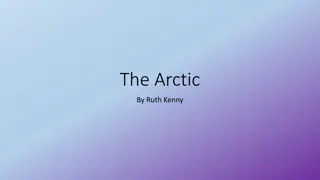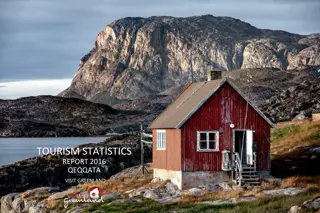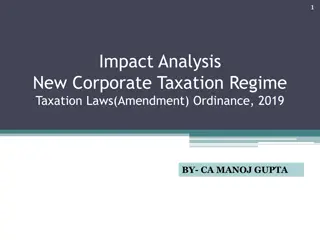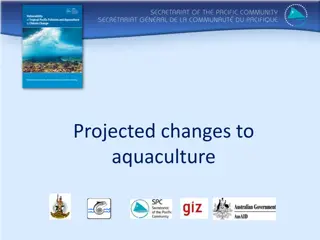Freshwater Fluxes from Greenland and Climate Regime Changes in the Arctic-North Atlantic System
Freshwater fluxes from Greenland are identified as a new regulator of climate regime changes in the Arctic-North Atlantic system. The Arctic Ocean Oscillation Index reveals two circulation regimes with alternating patterns. Correlations between the Arctic Ocean Oscillation and various environmental parameters provide insights into anomalies and sources affecting the system.
Download Presentation

Please find below an Image/Link to download the presentation.
The content on the website is provided AS IS for your information and personal use only. It may not be sold, licensed, or shared on other websites without obtaining consent from the author.If you encounter any issues during the download, it is possible that the publisher has removed the file from their server.
You are allowed to download the files provided on this website for personal or commercial use, subject to the condition that they are used lawfully. All files are the property of their respective owners.
The content on the website is provided AS IS for your information and personal use only. It may not be sold, licensed, or shared on other websites without obtaining consent from the author.
E N D
Presentation Transcript
Freshwater fluxes from Greenland as a new regulator of climate regime changes in the Arctic-North Atlantic system Andrey Proshutinsky1, Dmitry Dukhovskoy2and Mary- Louise Timmermans3 1Woods Hole Oceanographic Institution, Woods Hole 2Florida State University 3Yale University Freshwater and heat experiments 25 October, 2012, Woods Hole, MA
Arctic Ocean Oscillation Index (AOO) Analyzing simulated annual sea ice motion and ocean circulation in the Arctic Ocean, Proshutinsky and Johnson [1997] revealed two circulation regimes: cyclonic and anticyclonic alternating at intervals of 5-7 years with a period of 10-15 years. ACCR CCR H L L L Proshutinsky, A., Johnson, M., 1997. Two circulation regimes of the wind-driven Arctic Ocean. Journal of Geophysical Research 102, 12493 12512.
AOO index Arctic Ocean Oscillation gradient of sea surface heights (in red box) characterizing intensity and sign of circulation in the Arctic ACCR positive index CCR negative index 2007 1989 This method of index calculation is subjective but provides accurate information about sign of circulation and relative intensity
This index was calculated using annual circulation and sea surface height plots for 1946-1989 and then updated to the present
ACCR CCR
Correlations between AOO and environmental parameters Parameters Anomaly during ACCR CCR Source Vorticity over polar cap N P Tanaka et al., 1995 SLP P N Proshutinsky and Johnson, 1996, 1997 Surface air temperature N P Martin and Munoz, 1997 Duration of ice melt season N P Smith, 1998 Sea ice extent P N Maslanik et al, 1996 Ice drift speed N P Hakkinen and Proshutinsky, Siberian river runoff P N Proshutinsky and Johnson, 1997 Beaufort Gyre Freshwater content P N Proshutinsky et al., 2002, 2009 Ice extent in the Bering Sea P N Niebauer, 1988 Ice extent in Davis Strait P N Agnew, 1991 Sea level along Siberia N P Proshutinsky et al, 2004 Atlantic water temperature N P EWG atlas, 1997, 1998 Atlantic water salinity N P EWG atala, 1997, 1998
The Great Salinity Anomaly, a large, near-surface pool of fresher-than-usual water, was tracked as it traveled in the sub-polar gyre currents from 1968 to 1982. This surface freshening of the North Atlantic coincided very well with Arctic cooling of the 1970s. At this time warm cyclone trajectories were shifted south and heat advection to the Arctic by atmosphere was shutdown. Cold air Surface Warm deep water 1000 m
ACCR CCR Freshwater release Freshwater accumulation GSA 1970s GSA 1980s GSA 1990s
The recent anticyclonic circulation regime started in 1997, persisted through 2012 and lasted 16 years (except 2009) instead of the typical 5-8 years This also contradicts a bit the concept of warming climate. Under warming we should observe more cyclonic atmospheric and oceanic circulation. Instead we have observed the mostly pronounced anticyclonic regime. Note that similar situation was observed at the end of Arctic warming in the late 1940s. 8 years 4 years 7 years 5 years 5 years 9 years 5 years 8 years 16 years ! GSA 1970s GSA 1980s GSA 1990s
The most important question is can we predict decadal changes? In order to do this it is important to know mechanisms regulating decadal climate changes.
ACCR CCR
Hypothesis Arctic Ocean Greenland Sea form closed atmosphere-ice-ocean climatic system with auto- oscillatory behavior between two climate states with quasi-decadal periodicity The system is characterized by two opposite states: (1) ACCR - a cold Arctic and warm Greenland Sea region; (2) CCR - a warm Arctic and cold Greenland Sea region. Freshwater and heat fluxes regulate the regime shift in the system
Diagram of an idealized Arctic system model. Qf river runoff; Q(P-E) net precipitation (precipitation minus evaporation); Qmao flow from the mixed layer to the shelf; Qsh shelf water flow to the Arctic Ocean; Qice ice flux to the GIN Sea; QPW Polar water flux; Fadv sensible heat flux; Ftot surface heat flux. Dukhovskoy, D.S., M.A. Johnson, and A. Proshutinsky, 2004. Arctic decadal variability: An auto-oscillatory system of heat and fresh water exchange. GRL, 31, doi:10.1029/2 3GL019023. Dukhovskoy, D., M. Johnson, and A. Proshutinsky, 2006a. Arctic decadal variability from an idealized atmosphere-ice- ocean model: 1. Model description, calibration, and validation, J. Geophys. Res., 111, C06028, doi:10.1029/2004JC002821. Dukhovskoy, D., M. Johnson, and A. Proshutinsky , 2006b. Arctic decadal variability from an idealized atmosphere-ice- ocean model: 2. Simulation of decadal oscillations, J. Geophys. Res., 111, C06029, doi:10.1029/2004JC002820.
Simulation of the AOO External Forcing: Internal Parameters: - Solar radiation - Coefficient of heat advection - Wind stress - Water flux from the Arctic Ocean - River runoff - Inflow to the shelf box from the Arctic Ocean - Atlantic and Bering Strait inflows - Cloudiness - Air humidity - Ice/snow albedo
Model Results: Dynamic Height and SAT Gradients Annual mean dynamic height gradient between the Arctic Ocean and the Greenland Sea Annual mean SAT gradient between the Arctic Ocean and the Greenland Sea ACCR CCR max H min H
ACCR CCR 8 years 4 years 7 years 5 years 5 years 9 years 5 years 8 years 16 years ! GSA 1970s GSA 1980s GSA 1990s
ACCR CCR 8 years 4 years 7 years 5 years 5 years 9 years 5 years 8 years 16 years ! GSA 1970s GSA 1980s GSA 1990s
Germe, A., M.-N. Houssais, C. Herbaut, and C. Cassou (2011), Greenland Sea sea ice variability over 1979 2007 and its link to the surface atmosphere, J. Geophys. Res., 116, C10034, doi:10.1029/2011JC 006960. 2001 1997
Map showing the scaled magnitude of FW flux (the area of each triangle is proportional to the flux) for the five oceanographic units described in the text and the eight largest rivers into the Arctic Ocean. The numbers indicate the mean FW flux in km3yr 1 for the reference period 1961 1990 for each region and the percentages refer to the relative increase in flux for the period 1992 2010, based on a linear trend. Bamber et al., 2012 - GRL The solid lines delineate the five drainage basins: AO = Arctic Ocean, NS = Nordic Seas, IS = Irminger Sea, LS = Labrador Sea, BB = Baffin Bay.
AO FW flux to the Arctic Ocean NS FW flux to the Nordic Seas IS FW flux to the Irminger Sea
B) Time series of CCRs (red bars) and ACCRs (blue bars) simulated by our box model neglecting FW flux from Greenland; C) same as in (B) but with FW fluxes from Greenland introduced after 50 years in the model simulation; D) same as in (C) but with a doubling of FW fluxes from Greenland. Numbers by the bars indicate the regime duration in years.
B) Time series of CCRs (red bars) and ACCRs (blue bars) simulated by our box model neglecting FW flux from Greenland; C) same as in (B) but with FW fluxes from Greenland introduced after 50 years in the model simulation; D) same as in (C) but with a doubling of FW fluxes from Greenland. Numbers by the bars indicate the regime duration in years.
B) Time series of CCRs (red bars) and ACCRs (blue bars) simulated by our box model neglecting FW flux from Greenland; C) same as in (B) but with FW fluxes from Greenland introduced after 50 years in the model simulation; D) same as in (C) but with a doubling of FW fluxes from Greenland. Numbers by the bars indicate the regime duration in years.
ACCR CCR 8 years 4 years 7 years 5 years 5 years 9 years 5 years 8 years 16 years ! GSA 1970s GSA 1980s GSA 1990s
Germe, A., M.-N. Houssais, C. Herbaut, and C. Cassou (2011), Greenland Sea sea ice variability over 1979 2007 and its link to the surface atmosphere, J. Geophys. Res., 116, C10034, doi:10.1029/2011JC 006960. 2001 1997 Increase of sea ice coverage in the GIN Sea Less cyclonic acitivy Cooling climate And
2012 September minimum 2050 September minimum 2012 September ice minimum from NSIDC 1970 1980 1990 2000 2010 2020
2012 September minimum 2050 September minimum 1970 1980 1990 2000 2010 2020 2030 2040 2050 2060
The major scientific questions of this study are: Can we predict regime shifts and the long-term climate impacts of ACCRs and CCRs? What is the role of different mechanisms responsible for climate regime shifts before and after 2000? What are the primary characteristics of the long- duration ACCR observed in the 21st century? What conditions will typify a CCR of the 21st century, and how might the sea ice and ocean respond to future short duration cyclonic wind forcing?
Our idealized box model experiments suggest that anomalously large volumes of FW in the central GIN Sea may lead to the cessation of auto- oscillations in the Arctic system. Our hypothesis suggests that the source of this anomaly is increased FW flux from Greenland triggered by a warming global climate. One major unknown question is: How does this excessive FW end up in the central GIN Sea? We propose to study the pathways of FW in the GIN Sea and the mechanisms of lateral advection of FW to the convection regions of the GIN Sea from the boundary currents.























